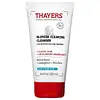What's inside
What's inside
 Key Ingredients
Key Ingredients

 Benefits
Benefits

 Concerns
Concerns

 Ingredients Side-by-side
Ingredients Side-by-side

Salicylic Acid 1.5%
MaskingWater
Skin ConditioningCoco-Glucoside
CleansingPropylene Glycol
HumectantGlycerin
HumectantAmmonium Polyacryloyldimethyl Taurate
Emulsion StabilisingSodium Cocoyl Isethionate
CleansingCoco-Betaine
CleansingSodium Methyl Cocoyl Taurate
CleansingSodium Chloride
MaskingSodium Hydroxide
BufferingPhenoxyethanol
PreservativeCitric Acid
BufferingCapryloyl Salicylic Acid
ExfoliatingHamamelis Virginiana Bark/Leaf/Twig Extract
Skin ConditioningAloe Barbadensis Leaf Extract
EmollientCoconut Acid
CleansingSodium Hyaluronate
HumectantTrisodium Ethylenediamine Disuccinate
Cymbopogon Citratus Extract
Skin ConditioningSalicylic Acid 1.5%, Water, Coco-Glucoside, Propylene Glycol, Glycerin, Ammonium Polyacryloyldimethyl Taurate, Sodium Cocoyl Isethionate, Coco-Betaine, Sodium Methyl Cocoyl Taurate, Sodium Chloride, Sodium Hydroxide, Phenoxyethanol, Citric Acid, Capryloyl Salicylic Acid, Hamamelis Virginiana Bark/Leaf/Twig Extract, Aloe Barbadensis Leaf Extract, Coconut Acid, Sodium Hyaluronate, Trisodium Ethylenediamine Disuccinate, Cymbopogon Citratus Extract
Water
Skin ConditioningGlycerin
HumectantCocamidopropyl Betaine
CleansingDecyl Glucoside
CleansingCitric Acid
BufferingPPG-2 Hydroxyethyl Cocamide
EmulsifyingPEG-16 Soy Sterol
EmulsifyingPolysorbate 20
EmulsifyingDisodium Lauroamphodiacetate
CleansingPhenoxyethanol
PreservativeButylene Glycol
HumectantSodium Coco Pg-Dimonium Chloride Phosphate
CleansingSodium Citrate
BufferingTetrasodium EDTA
Methylparaben
PreservativeXanthan Gum
EmulsifyingPropylparaben
PreservativeEthylparaben
PreservativePropylene Glycol
HumectantChrysanthemum Parthenium Extract
Skin ConditioningSodium Cocoyl Amino Acids
CleansingSarcosine
Skin ConditioningPotassium Aspartate
Skin ConditioningMagnesium Aspartate
Skin ConditioningSodium Hydroxide
BufferingWater, Glycerin, Cocamidopropyl Betaine, Decyl Glucoside, Citric Acid, PPG-2 Hydroxyethyl Cocamide, PEG-16 Soy Sterol, Polysorbate 20, Disodium Lauroamphodiacetate, Phenoxyethanol, Butylene Glycol, Sodium Coco Pg-Dimonium Chloride Phosphate, Sodium Citrate, Tetrasodium EDTA, Methylparaben, Xanthan Gum, Propylparaben, Ethylparaben, Propylene Glycol, Chrysanthemum Parthenium Extract, Sodium Cocoyl Amino Acids, Sarcosine, Potassium Aspartate, Magnesium Aspartate, Sodium Hydroxide
 Reviews
Reviews

Ingredients Explained
These ingredients are found in both products.
Ingredients higher up in an ingredient list are typically present in a larger amount.
Citric Acid is an alpha hydroxy acid (AHA) naturally found in citrus fruits like oranges, lemons, and limes.
Like other AHAs, citric acid can exfoliate skin by breaking down the bonds that hold dead skin cells together. This helps reveal smoother and brighter skin underneath.
However, this exfoliating effect only happens at high concentrations (20%) which can be hard to find in cosmetic products.
Due to this, citric acid is usually included in small amounts as a pH adjuster. This helps keep products slightly more acidic and compatible with skin's natural pH.
In skincare formulas, citric acid can:
While it can provide some skin benefits, research shows lactic acid and glycolic acid are generally more effective and less irritating exfoliants.
Most citric acid used in skincare today is made by fermenting sugars (usually from molasses). This synthetic version is identical to the natural citrus form but easier to stabilize and use in formulations.
Read more about some other popular AHA's here:
Learn more about Citric AcidGlycerin is already naturally found in your skin. It helps moisturize and protect your skin.
A study from 2016 found glycerin to be more effective as a humectant than AHAs and hyaluronic acid.
As a humectant, it helps the skin stay hydrated by pulling moisture to your skin. The low molecular weight of glycerin allows it to pull moisture into the deeper layers of your skin.
Hydrated skin improves your skin barrier; Your skin barrier helps protect against irritants and bacteria.
Glycerin has also been found to have antimicrobial and antiviral properties. Due to these properties, glycerin is often used in wound and burn treatments.
In cosmetics, glycerin is usually derived from plants such as soybean or palm. However, it can also be sourced from animals, such as tallow or animal fat.
This ingredient is organic, colorless, odorless, and non-toxic.
Glycerin is the name for this ingredient in American English. British English uses Glycerol/Glycerine.
Learn more about GlycerinPhenoxyethanol is a preservative that has germicide, antimicrobial, and aromatic properties. Studies show that phenoxyethanol can prevent microbial growth. By itself, it has a scent that is similar to that of a rose.
It's often used in formulations along with Caprylyl Glycol to preserve the shelf life of products.
Propylene Glycol is an odorless, colorless liquid. As a humectant, it helps skin retain moisture. It also aids in delivering active ingredients.
Another role of this ingredient is preventing a product from melting or freezing. Propylene glycol also adds antimicrobrial properties to a product, elongating product lifespan.
This ingredient is considered an organic alcohol and commonly added into both cosmetics and foods.
Those with sensitive skin or conditions may develop a rash when using this ingredient.
Learn more about Propylene GlycolSodium Hydroxide is also known as lye or caustic soda. It is used to adjust the pH of products; many ingredients require a specific pH to be effective.
In small amounts, sodium hydroxide is considered safe to use. However, large amounts may cause chemical burns due to its high alkaline.
Your skin has a natural pH and acid mantle. This acid mantle helps prevent harmful bacteria from breaking through. The acid mantle also helps keep your skin hydrated.
"Alkaline" refers to a high pH level. A low pH level would be considered acidic.
Learn more about Sodium HydroxideWater. It's the most common cosmetic ingredient of all. You'll usually see it at the top of ingredient lists, meaning that it makes up the largest part of the product.
So why is it so popular? Water most often acts as a solvent - this means that it helps dissolve other ingredients into the formulation.
You'll also recognize water as that liquid we all need to stay alive. If you see this, drink a glass of water. Stay hydrated!
Learn more about Water